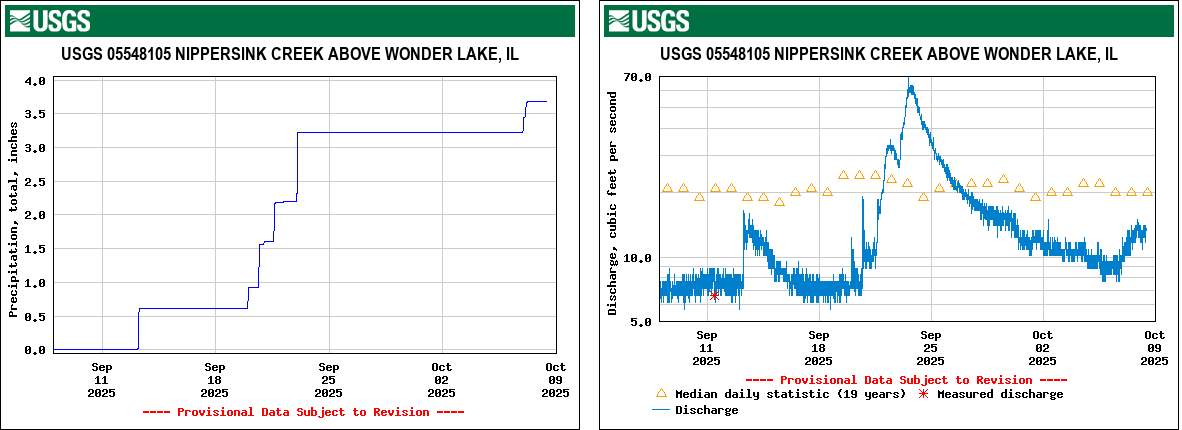1. The annual inspection of the Wonder Lake Dam and Sediment Drying Facility required by the State was conducted on October 3rd. In addition to MPOA and Village representatives, there were two engineers from the State, and three engineers from the MPOA engineering firm. All were favorably impressed by the on-going maintenance of these facilities. The accompanying engineering report which must be submitted to the State is expected by the end of the month, at which time it will be posted on the MPOA website.
2. The Nippersink Creek USGS stream gage at Thompson Road upstream of Wonder Lake recorded roughly 3.7 inches of rain over the past month. The gage also showed the corresponding “spikes” in streamflow from the rainfall events, as shown below in the second chart. Nippersink streamflow into the lake today is at roughly 15 cubic feet per second (cfs), which is still below the 30-year average of 20 cfs for this date.

3. The algae bloom continues but will begin to subside with cooler temperatures and increased stream inflows. Again, not raking / blowing leaves and grass clippings into the lake or tributary streams will help reduce un-needed nutrients going into the lake.
4. Another potential source of unwanted nutrient loading to lakes is from failing or poorly maintained septic systems. A properly functioning septic system adequately removes bacteria and nutrients, protecting human health. Phosphorus removal occurs mostly within septic leach field, while nitrogen removal occurs in septic tank and within leach field. Due to the development history of most lake communities, existing septic systems can often be antiquated and undersized and can be improperly maintained. In general, any septic system within 300 feet of a lake, stream, or drainageway is a source of phosphorus and nitrogen loading.
Impact of Leaking Septic Systems on Phosphorus Levels
Phosphorus and Algal Blooms
Leaking septic systems can significantly increase phosphorus levels in nearby water bodies. Phosphorus is a key nutrient that, in excess, promotes the rapid growth of algae, leading to harmful algal blooms (HABs). These blooms can deplete oxygen in the water, harming aquatic life and disrupting ecosystems.
How Septic Leaks Contribute to Pollution
- Nutrient Release: When septic systems fail or leak, untreated wastewater can seep into the soil and reach groundwater or surface waters. This wastewater often contains high levels of phosphorus and nitrogen.
- Eutrophication: The influx of nutrients from leaking septic systems can trigger eutrophication, a process where water bodies become overly enriched with nutrients. This results in excessive algae growth, which can lead to decreased water clarity and oxygen levels.
Health and Environmental Risks
- Public Health Concerns: Contaminated water from algal blooms can pose health risks to humans and animals, including toxins that can cause illness.
- Ecosystem Damage: Algal blooms can lead to fish kills and loss of biodiversity as aquatic habitats become unsuitable for many species.
Common Indicators of a Failing or Malfunctioning Septic System
- Sewage backing up in the basement or drains
- Ponded water or wet areas over the drain field
- Bright green grass over the drain field
- A dense stand of aquatic plants along your shoreline (lakeside residents)
- Sewage odors Bacteria or nitrate in nearby well water
- Biodegradable dye flushed through your system is detectable in the lake (lakeside residents)
Prevention and Maintenance
- To minimize the risk of phosphorus pollution from septic systems, regular maintenance is crucial. Homeowners should:
- Pump their septic tanks every 3 years, and possibly more often if a year-round residence with heavy use.
- Monitor for signs of system failure, such as slow drains, wet spots in your lawn, or unusual odors.
- Keep any heavy equipment or vehicles off your septic system.
- Ensure proper design and installation of septic systems to prevent leaks.
By taking these steps, homeowners can help protect local surface water and groundwater quality and prevent the negative impacts of nutrient pollution.
